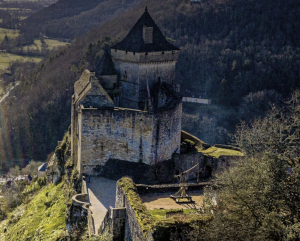The first task of the castle builder was to choose a suitable site.
堡壘建造者的首要任務是選擇一個合適的地點。
The castle's position in the landscape with respect to other fortified enclaves was key.
堡壘在景觀中相對于其他設防據點的位置是關鍵。
It was essential to have a clear view of other fortifications in order to receive strategic messages -- fiery beacons by night or smoke signals by day, which could warn of imminent danger, such as the incursion of an enemy army.
為了接收戰略信息,對其他防御工事有一個清晰的視野是至關重要的--夜晚的火光信號或白天的煙霧信號,這些信號可以警告迫在眉睫的危險,比如敵人的入侵。
The locale chosen had to command the surrounding area, especially strategic elements such as roads, bridges, and fords, while also offering access to agricultural and other resources.
所選地點必須能夠控制周邊地區,特別是戰略要素,如道路、橋梁和淺灘,同時還要提供對農業和其他資源的獲取途徑。
Other factors to consider were the availability of building materials and a water supply for filling wells, pools, and cisterns.
其他需要考慮的因素包括建筑材料的可用性和用于填井、水池和蓄水池的水源。
The castle's defenders needed to stockpile enough food and water to allow them to hold out in the case of a prolonged siege.
堡壘的守軍需要儲備足夠的食物和水,以便在長期圍困的情況下能夠堅持下去。
The next task was to secure the outer perimeter.
下一個任務是確保外圍的安全。
This meant building defenses around the access points as well as strategic locations, such as bridges and water sources.
這意味著要在入口點和戰略位置(如橋梁和水源)周圍建立防御。
If large enough, a moat made it difficult for the enemy to get close enough to the walls to do damage with projectiles or battering rams.
如果護城河足夠寬大,敵人就很難靠近城墻,從而無法用投射物或攻城錘進行破壞。
In places with dry climates and rocky terrain, the moats were usually dry, narrow, and deep.
在氣候干燥和多巖石地形的地方,護城河通常是干的、狹窄且深的。
In temperate climes and in flat areas with claylike soil, wide, shallow moats were dug and flooded with water.
而在溫帶地區和黏土土壤的平坦地區,會挖寬而淺的護城河,并將其灌滿水。
In the Iberian Peninsula, the Calatrava la Vieja Castle, which was fought over by Moorish and Christian forces throughout the 12th century, was built to turn the Guadiana River into a natural moat on its north side.
在伊比利亞半島,卡拉特拉瓦拉維耶哈堡壘在整個12世紀被摩爾人和基督教勢力爭奪,它的建成是為了將瓜迪亞納河北岸變成一條天然護城河。

A ditch dug around the rest of the castle was filled with water from the river.
圍繞堡壘其余部分的壕溝則用河水填滿。
Beyond the moat stood the outer walls of the castle complex.
在護城河外矗立著堡壘群的外墻。
Sometimes several walls were erected around the main enclosure, usually arranged concentrically.
有時會在主圍墻周圍建造幾道墻,通常呈同心圓排列。
This meant that, even if the enemy managed to break through the first line of defense, they could at least be ambushed before they reached the second.
這意味著,即使敵人設法突破了第一道防線,他們至少會在到達第二道防線之前遭到伏擊。
The walls were built high, making it difficult to fire arrows and other projectiles into the castle from outside.
城墻建得很高,這使得從外面向堡壘發射箭和其他投射物變得很困難。
The height also served to deter climbers who might try to slip in by stealth at night using ladders and take the castles by surprise.
這個高度也起到了阻止登山者的作用,他們可能會在晚上用梯子偷偷溜進去,出其不意地占領堡壘。
While challenging, this type of sneak attack was, apparently, not uncommon.
這個高度也起到了阻止那些可能試圖在夜間使用梯子偷偷潛入并出其不意地占領堡壘的人的作用。
According to the Andalusian chronicler and historian Ibn Sahib al-Salat, writing sometime before the end of the 12th century:
根據安達盧西亞編年史家、歷史學家伊本·薩希布·薩拉特在12世紀末的某個時間段所寫的文字:
"On rainy and very dark nights," Gerald the Fearless, a Portuguese Christian adventurer, "prepared his very long wooden ladders" and scaled castle walls and tower "in person."
“在下雨和非常黑暗的夜晚,”葡萄牙基督教冒險家、無畏的杰拉爾德“準備了他很長的木梯”,并“親自”爬上了堡壘的墻壁和塔樓。
Gerald was said to have climbed into numerous Almohad castles in present-day western Spain and Portugal by using this method.
據說,杰拉爾德用這種方法爬進了位于今天西班牙西部和葡萄牙的許多阿爾莫哈德堡壘。
This mode of attack was such a concern that the law code Las Siete Partidas, written in the mid-13th century by King Alfonso X of Castile, warned that castle walls must be built tall enough so that anyone attempting to enter via a ladder would be deterred.
這種攻擊方式引起了人們的極大關注,13世紀中葉,卡斯蒂亞國王阿方索十世撰寫的法律法典《Las Siete Partidas》警告說,堡壘的墻壁必須建得足夠高,以便阻止任何試圖通過梯子進入堡壘的人。



